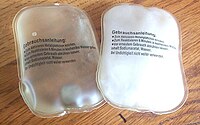
Photo from wikipedia
Abstract A shape-stabilized phase-change material (SSPCM) was installed on the floor, walls, and ceiling of various buildings, and its effects on indoor room temperature stabilization and heating load reduction were… Click to show full abstract
Abstract A shape-stabilized phase-change material (SSPCM) was installed on the floor, walls, and ceiling of various buildings, and its effects on indoor room temperature stabilization and heating load reduction were examined using experiments and simulations. The PCM model was developed based on the specific heat capacity of the SSPCM sheets measured using a thermostatic chamber and simulations results were obtained using EnergyPlus. The validity of the PCM model was examined by comparing the simulation and experimental results, which showed similar temperature tendency. The model was then examined to determine the applicability of PCM to the various climates in Japan through annual heating load simulations. The target buildings were classified as Type A (no PCM, reference), Type B (only the floor contained PCM), and Type C (the floor, walls, and ceiling contained PCM) using a standard Japanese house. Types B and C had the same amount of PCM. The simulation was run for 21 cases, with one being run for each type of building in seven Japanese climates. In addition, if the installation area of the PCM was expanded, the absorption area of solar radiation also increased; thus, the melting and solidification times of the PCM decreased and its heat storage increased. Thereby, diurnal temperature swing decreased and the efficiency of the PCM increased. The heat-storage performance changed depending on the installation area and position, even when the same amount of PCM was installed in the building. Therefore, when using PCMs in buildings, the installation area and position should be considered alongside the amount of PCMs.
Journal Title: Building and Environment
Year Published: 2017
Link to full text (if available)
Share on Social Media: Sign Up to like & get
recommendations!